|
An evening view from the deck of Snowshoe’s Sunrise Backcountry Hut. The town of Cass, WV lies in the distance. Photo by M. Scott Smith.
|
In Part 1 of my Snowshoe Firsthand Report, I described the drive to Snowshoe and the conditions (and food) I discovered there. On Saturday, all fog had lifted and skiers were treated to absolutely beautiful conditions on the mountain: a bright sun, temperatures in the mid-30’s, and forgiving, carve-friendly snow. I made first tracks on Cupp Run and Shay’s Revenge, both groomed overnight. The right half of Lower Shay’s Revenge had been groomed (leaving moguls on the left half), and for the first time, I was able to ski Lower Shay’s with some grace. On past visits, Lower Shay’s had been too icy.
Following a few runs down the mountain, I returned to the main Snowshoe basin area and had breakfast at the Boathouse, a small eating area adjacent to Shaver’s Lake and the bottom of the Ball Hooter express lift. The Boathouse has excellent homemade waffles, topped by strawberries, blueberries, whipped cream, butter, or some combination thereof. The sunny skies and just-above-freezing temperatures made our seating choice clear: outside at picnic tables overlooking the lake. The lake, it should be pointed out, freezes on top but stays liquid underneath. (If this point doesn’t seem fascinating, don’t worry: it’s an inside joke that only one or two readers will get.) This prevents Snowshoe from offering ice skating on the lake, although during the summer, activities such as canoeing are offered.
Conditions throughout Saturday remained in peak form. As is often the case on weekends, the line at the base of Ball Hooter becomes a choking point, growing throughout the day. A lift attendant did an admirable job filling each chair with four people. If lines become too unbearable, head to Silver Creek: there’s almost never a line at the slopes just down the road. Or, visit Snowshoe midweek and avoid lines altogether.
In Part 2 of my Firsthand Report, I dive into greater detail on several topics: Snowshoe’s Sunrise Backcountry Hut, Grooming the Slopes, Of Trees and Squirrels (and Salamanders), and Snowshoe TV. Enjoy!
A couple seasons ago, Snowshoe built a log cabin off of the Cheat Mountain Ridge, a location nestled two miles away from the resort and offering a grand view. This rustic cabin, built entirely from local lumber, offers a unique dining and lodging experience.
Don’t plan on driving to the Backcountry Hut - there’s no road there. Options for visiting the hut include cross country skiing, snowshoeing, an ATV ride, or snowmobiling. I joined a number of colleagues in snowmobiling to the hut, an exhilirating ride out to the hut as the sun set and in the pristine darkness of night on the way back.
Visitors can choose to dine at the hut, or dine and spend the night. The cost of dining with transport is $175 per couple. Add $75 per room if you wish to spend the night. A hutmaster manages the hut and provides all cooking, as well as anecdotes about West Virginia.
Upon our arrival at the hut, a mug of hot apple cider (with a stick of cinnamon) awaited us, while dinner cooked deckside on the grill. A number of appetizers preceded a delicious dinner that included a salad, grilled salmon and vegetables, and a berry cobbler made from native West Virginia berries. All hit the spot perfectly.
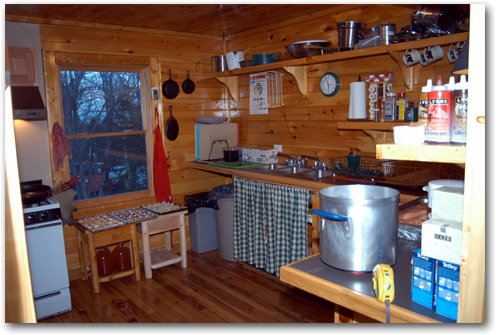
|
|
The well-equipped kitchen of the Backcountry Hut. But don’t worry - the hutmaster will do all the cooking. Photo by M. Scott Smith.
|
Following dinner, we appreciated the starlit night for awhile and then saddled up on our snowmobiles for the journey back to Snowshoe. If you have a chance to visit the Backcountry Hut, don’t miss out on the experience. (To learn more about the Backcountry Hut, read Matthew Graham’s story on DCSki from last season.)
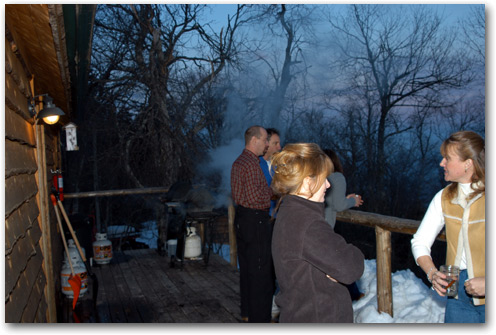
|
|
Chilling on the deck. Photo by M. Scott Smith.
|
It is not often that an opportunity arises to ride in a snowcat, so when the opportunity arose Thursday night, I couldn’t turn it down.
Each night, a fleet of snowcats painstakingly grooms every inch of selected slopes at Snowshoe so that visitors will be greeted by familiar cordoruy conditions the next day. The process of grooming is as much art as it is science; perfectly grooming a slope requires careful coordination and teamwork by a team of groomers, and an eye on weather and current slope conditions.
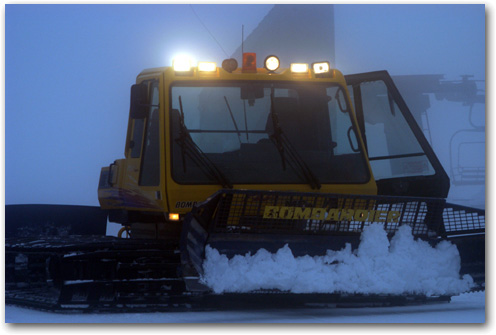
|
|
A Bombardier groomer grooming the slopes. Today’s groomers are state-of-the-art, including such luxuries as heat and CD players. Talk about an office with a view. Photo by M. Scott Smith.
|
Bill Jones is the Nighttime Supervisor of snowmaking at Snowshoe, but is also an expert at grooming and offered me a ride in a snowcat to show me what’s required to groom a slope. Bill’s enthusiasm was contagious; like many long-time Snowshoe employees, he is passionate about his work and enjoys spending time on the mountain. Bill and his colleagues work throughout the night, while everyone is sleeping, to make snow and ensure visitors will face optimum conditions when the ropes drop each morning.
The diesel-powered snowcats are quite agile, able to climb down the steepest inclines while offering many adjustable options to scoop and sift the snow just so. At times, it feels like the snowcat might flip over on a steep slope, but Bill assured me this doesn’t happen, even on the steepest slopes.
During the ride, Bill offered a wealth of information on what it takes to keep Snowshoe’s slopes in tip-top shape. Each night, the resort must decide which, if any, slopes to groom. This decision is made after studying current and projected weather conditions. Temperature and humidity play a large role in both snowmaking and grooming. If it’s much above freezing, or if humidity is close to 100%, grooming can be counterproductive, unnecessarily eating away at the base without improving conditions. If the temperature is above freezing but projected to dip below freezing during the night, Snowshoe will usually start grooming so there’s sufficient time to hit all the necessary slopes. With over 50 slopes, it can take a team of groomers all night to groom.
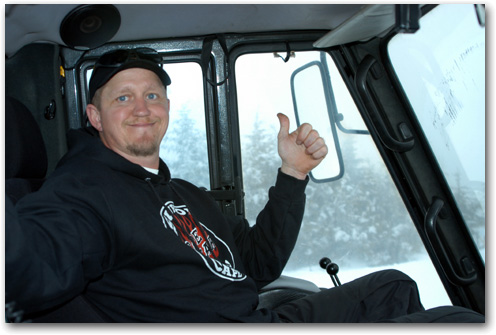
|
|
Snowshoe veteran Bill Jones of Mingo, WV spends most of his nights leading Snowshoe’s snowmaking efforts, or helping out to groom snow when the snowguns aren’t firing. Photo by M. Scott Smith.
|
The grooming team also relies on input from the Ski Patrol, for example to determine the most appropriate time to smooth out bumps on Lower Shay’s.
Covering slopes with skiable snow requires a delicate balance of snowmaking and snow grooming. This season, Snowshoe has received so much natural snow (nearly 200 inches) that very little snowmaking has been required. Snowmaking helped the resort grab a November opening date, but since then, snowmaking has been used mostly to patch problem areas. The guns have been completely silent for the second half of February, as grooming and natural snow has kept the slopes in remarkable shape.
Snowmaking is a very expensive operation, so Mother Nature’s contribution in the form of natural snow has saved Snowshoe and many other Mid-Atlantic resorts substantial money this season. Over the past few years, other innovations have helped decrease the cost and environmental impact of snowmaking. New snow towers use considerably less compressed air than guns of old, and resorts such as Snowshoe have worked to quickly upgrade their snowmaking systems with these new guns to increase efficiency and decrease costs. Snowshoe has also been working to computerize its entire snowmaking system; the compressor building, for example, is already computerized.
At the bottom of the Ball Hooter lift, the manmade Shaver’s Lake provides a large reserve of water available for snowmaking. (As snow melts from the slopes, it drains back into the lake.) Snowshoe has expanded Shaver’s Lake in recent years to increase snowmaking capacity and act as insurance against droughts.
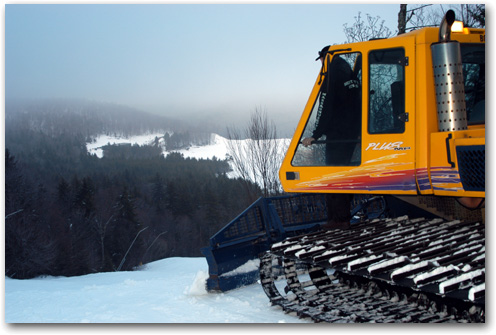
|
|
Taking a break from grooming to catch a view of Shaver’s Lake, which feeds Snowshoe’s snowmaking. A building in the distance is Snowshoe’s main compressor building. Photo by M. Scott Smith.
|
This increase in snowmaking capacity will allow the resort to add additional terrain, and an effort is currently underway to widen many slopes at the main Snowshoe area, reducing some trail mergings and providing space for a new Superpipe and more permanent terrain park at the Snowshoe area, set to debut next season.
You will see tree clearing in progress right now, and the reason might surprise you. Snowshoe is home to the West Virginia Northern Flying squirrel and a special species of salamander. These unique animals begin nesting in the spring, and neither species would appreciate having their home disturbed by falling timber. To allow these nesting sites to remain undisturbed during the clearing process, Snowshoe is completing all clearing prior to April.
Plans are also in the works to add additional terrain in the Western Territory, although a timetable is not yet in place and is dependent on environmental studies. Current plans call for adding some additional terrain to the right of Cupp Run, offering a pitch comparable to Lower Shay’s at the lower parts of the mountain. Years ago, the Western Territory included a number of additional runs which trees reclaimed long ago. Some of these runs may return, but don’t expect new terrain to debut in the Western Territory until sometime after next season, and possibly for several years.
Most major cities have one (or more) TV stations. Snowshoe Mountain Resort also has its own TV station, and it rivals the capabilities of other, much larger stations.
Snowshoe TV is an effort of Snowshoe’s Communications Department, led by Director of Communications Joe Stevens. The effort was launched six years ago by Joe and Kelly Stern. Since then, the TV side has become a big part of Snowshoe’s overall media and public relations plan. Handling the production side, Kristie Hewitt serves as Executive Producer, and Mark Lackner and David Romero serve as Producers. Joe and Communications Coordinator Loryn Kasten interface with networks and TV stations, offering video services.
The most visible production of Snowshoe TV is Channel 6, available on televisions throughout properties at the resort. Channel 6 provides an updated morning Snow Report and a daily afternoon Entertainment Report produced by Kristie’s staff and hosted by Joe and Loryn. In addition to these daily programs, Channel 6 offers a wide variety of year-round original content. The small but dedicated full-time staff of Snowshoe TV is also responsible for producing video sent to other networks throughout the country. Snowshoe partners with West Virginia Tourism in providing video from their events, such as the World Championships of Whitewater Rafting and the WV Tourism Conference. The staff also produces video content for the web, available off of Snowshoe’s web site.
Snowshoe is the only resort in the country to have its own satellite uplink truck, which allows the resort to beam live video from anywhere on the mountain to anywhere in the world. No other ski resort has this capability, and it’s a capability Snowshoe is quite proud of.
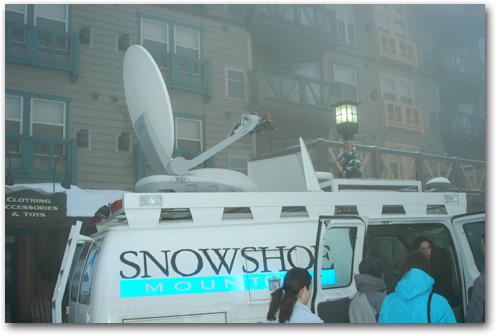
|
|
Enthusiastic members of Snowshoe’s TV Staff provide a tour of the resort’s own satellite uplink truck. Photo by M. Scott Smith.
|
This capability has proven extraordinarily useful for Snowshoe’s staff. Television stations and networks frequently request video from the resort to include in newscasts. In the past, Snowshoe had to mail out video or drive to the nearest facility with satellite uplink capability, in Charleston. This added delay and cost, and Snowshoe had no way of broadcasting video feeds of live events.
Snowshoe’s TV truck includes numerous A/V capabilities, such as the ability to edit digital video on the road. It also includes a satellite dish that can be raised into position, allowing the truck to beam live video into space, bouncing off a satellite and returning to any location interested in receiving the feed. (For live broadcasting, TV stations can either transmit video to a satellite, or send it via microwave to a microwave tower. Microwave transmission is less expensive and traditionally used in urban areas such as big cities, but there are no microwave towers anywhere close to Snowshoe, so Snowshoe’s truck only has a satellite dish.)
National networks such as CNN and The Weather Channel often request live video feeds from Snowshoe, and Snowshoe is able to quickly position the truck and uplink to a satellite. During Christmas, Santa visited Snowshoe’s slopes, and video of the event was fed live to outlets such as The Weather Channel. Because Snowshoe is the only resort that can offer this service, there is a distinct marketing benefit, and as a result, Snowshoe has prominent exposure at media outlets throughout the country.
Snowshoe’s TV studio offers more advanced editing capabilities. The resort uses nonlinear digital video editing, and recently switched to using Apple’s Final Cut Pro on PowerMac G4 systems. Apple’s new video editing technology allows broadcast-quality video to be edited on a laptop; Final Cut Pro, a PowerBook, and a high-quality digital video camera can be bought for less than $9,000, significantly reducing the cost of editing. This allows reporters in the field to be self-sufficient, producing and editing their own stories on the road instead of relying on a full staff and post-production work in the studio. (DCSki has a soft place in its heart for PowerBooks; every page you view on the site is created on a PowerBook.)
The satellite truck was not inexpensive, but Kristie explains that the truck is beginning to pay off in unexpected ways. There are not many satellite trucks in the state of West Virginia, but breaking news can happen anywhere. Frequently, Snowshoe’s truck is the closest satellite uplink facility available, and other networks such as MSNBC occasionally request assistance from Snowshoe. This provides an additional revenue stream for Snowshoe TV and helps fund the ongoing costs of the truck.
All photos by M. Scott Smith, taken on Feb. 28 and Mar. 1, 2003.
M. Scott Smith is the founder and Editor of DCSki. Scott loves outdoor activities such as camping, hiking, kayaking, skiing, and mountain biking. He is an avid photographer and writer.